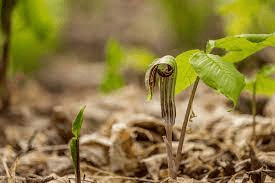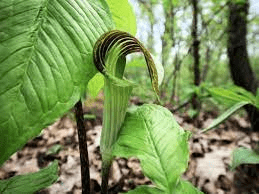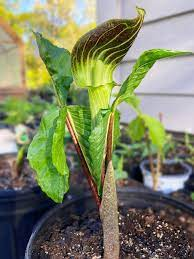Arisaema triphyllum, commonly known as Jack-in-the-pulpit, is a fascinating herbaceous perennial native to woodland habitats of eastern North America. This distinctive plant belongs to the Araceae family and is prized for its unique structure and striking appearance.
The Jack-in-the-pulpit features a single, erect stalk that emerges from the forest floor in spring, reaching heights of up to two feet.
At the top of the stalk, a hooded spathe, resembling a pulpit, encases a central spadix, which is often striped with purple or green hues. This arrangement mimics a preacher (Jack) standing in a pulpit, hence the plant’s common name.
One of the most intriguing aspects of Arisaema triphyllum is its unusual method of reproduction. The plant is dioecious, meaning individual specimens are either male or female.
Male plants produce a cluster of small, inconspicuous flowers on the spadix, while female plants bear a single, larger flower cluster. After pollination by insects attracted to its foul odor, the female plants develop clusters of bright red berries, adding a splash of color to the woodland landscape.
Jack-in-the-pulpit is not only visually captivating but also plays an important ecological role. Its berries provide a valuable food source for birds and small mammals, while its presence in the forest understory contributes to biodiversity and habitat complexity.
Despite its ornamental appeal, Jack-in-the-pulpit should be handled with caution due to its toxic nature. All parts of the plant contain calcium oxalate crystals, which can cause irritation and swelling if ingested or if the plant’s sap comes into contact with the skin.
Gardeners and nature enthusiasts alike appreciate Arisaema triphyllum for its unique form, intriguing reproductive biology, and contribution to woodland ecosystems. Whether encountered in its native habitat or cultivated in gardens, the Jack-in-the-pulpit never fails to captivate with its singular presence and botanical intrigue.
The Botanical Description of Arisaema triphyllum
1. Leaf Structure: The plant typically produces a single, umbrella-like leaf divided into three leaflets, giving it the triphyllum epithet.
2. Inflorescence: The distinctive feature is the spathe-and-spadix structure, resembling a hooded preacher, with the spathe enveloping the spadix.
3. Height: Jack-in-the-pulpit can reach heights of 1 to 2 feet, with a unique appearance that makes it easily identifiable in woodland environments.
4. Coloration: The spathe displays various colors, including green, brown, or purple, providing additional visual interest.
5. Habitat: Thriving in moist woodlands, the plant prefers rich, well-drained soils, contributing to its widespread distribution.
6. Bloom Time: Arisaema triphyllum blooms in spring, attracting pollinators with its unusual structure.
7. Berries: After flowering, the plant develops bright red berries, providing a food source for wildlife.
8. Lifecycle: As a perennial, Jack-in-the-pulpit regenerates each year from its tuberous rhizome.
9. Sexual Dimorphism: Some populations exhibit sexual dimorphism, with certain plants producing only male or female flowers.
10. Native Range: Found in Eastern North America, Arisaema triphyllum has a broad native range, spanning from the eastern United States to parts of Canada.
The Geographic Distribution of Arisaema triphyllum

1. North America: Jack-in-the-pulpit is primarily found in the eastern regions of North America, including the United States and Canada.
2. Eastern United States: This plant is widespread throughout the eastern United States, ranging from Maine to Florida and westward to Texas and Minnesota.
3. Woodlands: Arisaema triphyllum thrives in moist woodlands, often growing in the understory of deciduous forests.
4. Soil Preferences: It prefers rich, well-drained soils and is commonly found near streams, rivers, and other bodies of water.
5. Habitat Diversity: While it favors wooded areas, Jack-in-the-pulpit can also be found in swamps, meadows, and along forest edges.
6. Altitudinal Range: This species can be found at various elevations, from low-lying areas to mountainous regions.
7. Native Canadian Provinces: In Canada, Arisaema triphyllum is found in provinces such as Ontario, Quebec, New Brunswick, and Nova Scotia.
8. Cultivation: Due to its unique appearance and adaptability, Jack-in-the-pulpit is also cultivated as an ornamental plant in gardens and landscapes.
9. Naturalization: In some areas, Jack-in-the-pulpit has naturalized beyond its native range, particularly in regions with similar environmental conditions.
10. Importance in Ecosystems: This plant plays a role in forest ecosystems, providing habitat and food for various wildlife species, including birds and small mammals.
The Chemical Composition of Arisaema triphyllum
1. Calcium Oxalate: The plant contains calcium oxalate crystals, which can cause irritation and discomfort if ingested raw.
2. Alkaloids: Jack-in-the-pulpit contains alkaloids such as aristolochic acid, which have been studied for their potential medicinal properties.
3. Glycosides: Certain glycosides found in Arisaema triphyllum may contribute to its bitter taste and could have physiological effects.
4. Flavonoids: Flavonoids are present in various parts of the plant and are known for their antioxidant properties.
5. Saponins: These compounds have detergent-like properties and may play a role in the plant’s defense mechanisms.
6. Tannins: Tannins are astringent compounds that can be found in the leaves and stems of Jack-in-the-pulpit.
7. Resins: Resins are present in the plant and may serve protective functions against pests and pathogens.
8. Essential Oils: Some varieties of Arisaema triphyllum contain essential oils, which contribute to their aromatic properties.
9. Proteins: The plant contains proteins that are essential for its growth and development.
10. Carbohydrates: Carbohydrates serve as an energy source for the plant and are found in various forms, including sugars and starches.
Read Also: 17 Medicinal Health Benefits Of Ambrosia psilostachya (Western Ragweed)
The Medicinal Health Benefits Of Arisaema triphyllum (Jack-in-the-pulpit)

1. Anti-inflammatory Properties: Jack-in-the-pulpit has been used topically to alleviate inflammation and pain associated with conditions such as arthritis and rheumatism.
2. Respiratory Support: In traditional medicine, preparations of Arisaema triphyllum have been used to relieve respiratory ailments like coughs, colds, and bronchitis.
3. Digestive Aid: Some herbalists recommend Jack-in-the-pulpit for digestive issues, including indigestion, bloating, and diarrhea.
4. Wound Healing: Poultices made from the plant have been applied to wounds and skin irritations to promote healing and reduce infection.
5. Antimicrobial Activity: Certain compounds in Jack-in-the-pulpit may possess antimicrobial properties, helping to combat infections caused by bacteria, fungi, and other pathogens.
6. Pain Relief: The plant has been traditionally used as a pain reliever for various conditions, including headaches, muscle aches, and menstrual cramps.
7. Respiratory Congestion: Inhalation of steam infused with Jack-in-the-pulpit may help clear congestion and improve breathing during respiratory infections.
8. Antioxidant Effects: Some research suggests that Arisaema triphyllum contains antioxidants that may help protect cells from damage caused by free radicals.
9. Antiemetic Properties: Traditional practitioners have used preparations of the plant to alleviate nausea and vomiting.
10. Immunomodulatory Effects: There is some evidence to suggest that certain compounds in Jack-in-the-pulpit may modulate the immune system, potentially enhancing its function.
11. Anti-cancer Potential: Preliminary studies have explored the potential anti-cancer properties of compounds found in Arisaema triphyllum, although further research is needed to confirm these effects.
12. Menstrual Support: In traditional medicine, Jack-in-the-pulpit has been used to regulate menstrual cycles and alleviate symptoms associated with menstruation.
13. Antispasmodic Actions: The plant has been employed to reduce muscle spasms and cramping, offering relief from conditions like colic and irritable bowel syndrome (IBS).
14. Cardiovascular Support: Some herbalists suggest that Jack-in-the-pulpit may have beneficial effects on cardiovascular health, such as regulating blood pressure and improving circulation.
15. Urinary Tract Health: Traditional uses of Arisaema triphyllum include promoting urinary tract health and alleviating symptoms of urinary tract infections (UTIs).
The Methods of Usage to Achieve the Provided Health Benefits Of Arisaema triphyllum (Jack-in-the-pulpit)
1. Topical Application: Poultices or compresses made from the crushed leaves or roots can be applied topically to inflamed or painful areas to alleviate discomfort.
2. Infusion: Brewing the dried leaves or root of Jack-in
-the-pulpit as a tea allows for internal consumption, providing potential benefits for respiratory, digestive, and menstrual issues.
3. Tincture: Alcohol-based tinctures made from the plant material offer a concentrated form of its medicinal properties and can be taken orally in small doses.
4. Salve or Ointment: Creating a salve or ointment by combining Jack-in-the-pulpit with a carrier oil or beeswax allows for easy topical application to wounds, cuts, or skin irritations.
5. Steam Inhalation: Inhaling steam infused with the essential oils or volatile compounds of the plant can help alleviate respiratory congestion and support respiratory health.
6. Capsules or Tablets: For convenience, dried and powdered Jack-in-the-pulpit may be encapsulated or pressed into tablets for oral consumption, following recommended dosage guidelines.
7. Herbal Bath: Adding dried or fresh leaves or root to a warm bath allows for absorption of the plant’s beneficial compounds through the skin, promoting relaxation and potential pain relief.
8. External Wash: Infusions or decoctions of Jack-in-the-pulpit can be used as a wash or rinse for skin conditions, such as rashes, eczema, or insect bites.
9. Gargle or Mouthwash: Diluting an infusion of Jack-in-the-pulpit with water can create a gargle or mouthwash for sore throats or oral infections, providing antimicrobial and anti-inflammatory effects.
10. Inhalation Therapy: Using a diffuser or steam inhaler to disperse the aroma of Jack-in-the-pulpit essential oil may offer respiratory support and promote relaxation.
11. Dietary Supplement: Incorporating small amounts of dried or powdered Jack-in-the-pulpit into culinary preparations, such as soups or stews, may provide mild digestive support and enhance flavor.
12. External Compress: Soaking a cloth in a warm decoction of Jack-in-the-pulpit and applying it as a compress to swollen joints or muscles may help reduce inflammation and discomfort.
13. Herbal Syrup: Boiling down a decoction of Jack-in-the-pulpit with sweeteners like honey or maple syrup can create a soothing herbal syrup for coughs or respiratory congestion.
The Side Effects Of Using Arisaema triphyllum Medicinal Plant
1. Gastrointestinal Irritation: Ingesting raw or improperly prepared parts of the plant can cause irritation to the mouth, throat, and gastrointestinal tract due to the presence of calcium oxalate crystals.
2. Toxicity: Jack-in-the-pulpit contains compounds that may be toxic if consumed in large quantities or without proper preparation. It’s essential to use caution and follow recommended dosage guidelines.
3. Skin Sensitivity: Direct contact with the plant’s sap or juices may cause skin irritation or allergic reactions in some individuals. It’s advisable to wear gloves when handling the plant.
4. Respiratory Irritation: Inhaling powdered or aerosolized plant material may irritate the respiratory tract, leading to coughing, wheezing, or throat irritation.
5. Photosensitivity: Some individuals may experience increased sensitivity to sunlight (photosensitivity) after using Jack-in-the-pulpit topically. It’s advisable to avoid sun exposure or use sunscreen after topical application.
6. Digestive Upset: Ingesting large doses of Jack-in-the-pulpit or using it for an extended period may cause digestive discomfort, including nausea, vomiting, diarrhea, or abdominal cramping.
7. Allergic Reactions: Individuals with allergies to plants in the Araceae family, such as skunk cabbage or calla lily, may also be allergic to Jack-in-the-pulpit and should use it with caution.
8. Pregnancy and Lactation: Due to the lack of safety data, pregnant or breastfeeding women should avoid using Arisaema triphyllum medicinally, as it may pose risks to maternal and fetal health.
9. Interactions with Medications: Jack-in-the-pulpit may interact with certain medications, including blood thinners, antiplatelet drugs, and medications metabolized by the liver. Consult with a healthcare professional before using this plant if you are taking medications.
10. Renal Health: Individuals with kidney stones, kidney disease, or a history of calcium oxalate-related issues should avoid using Arisaema triphyllum due to its oxalate content, which may exacerbate these conditions.
11. Respiratory Sensitivity: Individuals with asthma or other respiratory conditions should use caution when inhaling plant material or essential oils, as it may trigger respiratory symptoms or exacerbate existing respiratory issues.
12. Neurological Effects: In rare cases, ingestion of certain compounds found in Jack-in-the-pulpit may lead to neurological symptoms such as dizziness, confusion, or seizures.
13. Children and Pets: Keep Jack-in-the-pulpit plants and products out of reach of children and pets, as ingestion may cause serious adverse effects.
14. Skin Reactions: Some individuals may experience skin reactions such as itching, redness, or rash after topical application of Jack-in-the-pulpit preparations. Discontinue use if adverse reactions occur.
15. Plant Identification: Properly identify Arisaema triphyllum to avoid confusion with similar-looking plants, as misidentification may lead to unintended ingestion of toxic species.
16. Pre-existing Conditions: Individuals with pre-existing health conditions or compromised immune systems should exercise caution and consult with a healthcare professional before using Arisaema triphyllum medicinally.
Read Also: 17 Medicinal Health Benefits Of Aquilegia formosa (Western Columbine)
The Scientific Research and Studies of Arisaema triphyllum

1. Anti-inflammatory Activity: Studies have demonstrated the anti-inflammatory effects of Arisaema triphyllum extracts, which may help alleviate pain and swelling associated with inflammatory conditions like arthritis and gout.
2. Antimicrobial Properties: Research suggests that certain compounds in Jack-in-the-pulpit possess antimicrobial activity against bacteria, fungi, and other pathogens, making it a potential candidate for the development of novel antimicrobial agents.
3. Analgesic Effects: Animal studies have shown that extracts of Arisaema triphyllum possess analgesic properties, reducing pain responses in experimental models.
4. Antioxidant Capacity: Jack-in-the-pulpit contains antioxidants that scavenge free radicals and protect cells from oxidative damage, potentially contributing to its overall health-promoting effects.
5. Anticancer Potential: Preliminary studies have explored the anticancer properties of Arisaema triphyllum extracts, showing promising results in inhibiting the growth of cancer cells and inducing apoptosis (programmed cell death).
6. Immunomodulatory Effects: Research suggests that certain compounds in Jack-in-the-pulpit may modulate immune responses, potentially enhancing immune function and promoting overall health.
The Safety Precautions and Recommendations In Using Arisaema triphyllum Medicinal Plant
1. Proper Identification: Ensure accurate identification of Arisaema triphyllum to avoid confusion with toxic plants, as misidentification can lead to accidental ingestion and adverse effects.
2. Avoid Ingesting Raw Plant Material: Raw or improperly prepared parts of Jack-in-the-pulpit contain calcium oxalate crystals, which can cause irritation and discomfort. Cook or process the plant thoroughly before consumption.
3. Consult with a Healthcare Professional: Before using Arisaema triphyllum medicinally, especially in the form of teas, tinctures, or supplements, consult with a qualified healthcare professional, particularly if you have underlying health conditions, are pregnant or breastfeeding, or are taking medications.
4. Start with Small Doses: If using Jack-in-the-pulpit for the first time, start with small doses and monitor for any adverse reactions. Discontinue use if any negative symptoms occur.
5. Use Caution with Children and Pets: Keep Jack-in-the-pulpit plants and products out of reach of children and pets, as ingestion may cause serious adverse effects. Educate family members about the potential dangers of the plant.
6. Wear Protective Gear: When handling Jack-in-the-pulpit plants or preparing herbal remedies, wear gloves and protective clothing to avoid skin irritation and allergic reactions.
7. Store Safely: Store dried plant material, extracts, or herbal preparations in a cool, dry place, out of reach of children and pets.
8. Follow Dosage Guidelines: If using Arisaema triphyllum as a herbal remedy, follow recommended dosage guidelines provided by a qualified herbalist or healthcare professional. Avoid exceeding recommended doses.
9. Monitor for Allergic Reactions: Be vigilant for signs of allergic reactions, such as itching, swelling, or difficulty breathing, and seek medical attention if necessary.
10. Discontinue Use if Adverse Effects Occur: If you experience any adverse effects or discomfort after using Jack-in-the-pulpit, discontinue use immediately and consult with a healthcare professional.
FAQs About Arisaema triphyllum Medicinal Plant
1. Is Arisaema triphyllum safe to consume?
While Arisaema triphyllum offers potential health benefits, it contains compounds that can be toxic if ingested raw or in large quantities. Proper preparation and dosage are essential to minimize the risk of adverse effects.
2. Can pregnant or breastfeeding women use Arisaema triphyllum?
Pregnant or breastfeeding women should avoid using Arisaema triphyllum medicinally due to the lack of safety data. It’s best to consult with a healthcare professional before using this plant during pregnancy or lactation.
3. How should I prepare Arisaema triphyllum for medicinal use?
Arisaema triphyllum can be prepared in various forms, including teas, tinctures, poultices, and topical salves. Ensure proper cooking or processing to neutralize any potentially harmful compounds before use.
4. Are there any known drug interactions with Arisaema triphyllum?
Some compounds in Arisaema triphyllum may interact with certain medications, including blood thinners, antiplatelet drugs, and medications metabolized by the liver. Consult with a healthcare professional before using this plant if you are taking medications.
5. What should I do if I experience adverse effects after using Arisaema triphyllum?
If you experience any adverse effects or discomfort after using Arisaema triphyllum, discontinue use immediately and seek medical attention if necessary. Be sure to inform your healthcare provider about your use of herbal remedies.
6. Can I grow Arisaema triphyllum in my garden?
Arisaema triphyllum can be cultivated as an ornamental plant in gardens and landscapes, provided it is grown in suitable conditions. Ensure proper soil drainage and partial shade to mimic its natural woodland habitat.
7. Is Arisaema triphyllum invasive?
While Arisaema triphyllum can spread via rhizomes in favorable conditions, it is not considered invasive in most areas. However, be mindful of its growth habits and potential to naturalize in certain environments.
8. Can I forage for wild Arisaema triphyllum?
Foraging for wild Arisaema triphyllum can be done with caution and proper identification. Be sure to harvest sustainably and ethically, avoiding overharvesting and damage to natural habitats.
9. What other plants are related to Arisaema triphyllum?
Arisaema triphyllum belongs to the Araceae family, which includes other plants such as skunk cabbage (Symplocarpus foetidus) and calla lily (Zantedeschia spp.). Some members of this family share similar growth habits and toxicity concerns.
10. Are there any cultural or historical uses of Arisaema triphyllum?
Arisaema triphyllum has a long history of traditional use by indigenous peoples for various medicinal purposes. It has also been used in folklore and spiritual practices for its unique appearance and symbolism.
Read Also: How to Graft an Avocado Tree to Produce Avocado Frui





